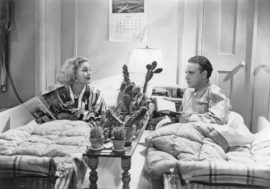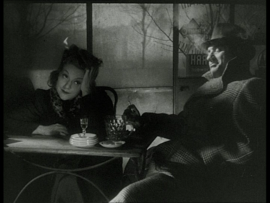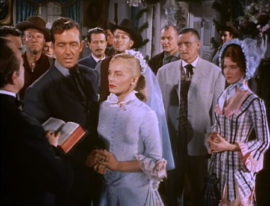This year’s Cinema Ritrovato program, on which we’ll be reporting throughout the week (see Bart Versteirt’s report here), again showcases discoveries, rediscoveries and restorations from international film archives. The program of this 27th edition stays true to its familiar structure: there’s the historiographic section “Cento Anni Fa,” recreating a typical night at the movies from one hundred years ago; a thematic section, this year focusing on the imminence of the War as conveyed through European, British and American movies from 1938-1939; a technical-stylistic section devoted both to the little-known European widescreen cinema, the coming of sound in Japan, and the visual qualities of the photochemical film stock used in Czech films from 1963-1968; and a number of auteurist programs dedicated to canonical or less canonical figures like Chaplin (whose Mutual films are on view in resplendent restored prints), silent Hitch, De Sica, Jerry Lewis, Burt Lancaster (represented here by his daughter Joanna), Chris Marker, the husband-and-wife team of pioneering Russian filmmakers Olga Preobrazenskaja and Ivan Pravov, and “Noble Primitive” Allan Dwan. As anyone who’s been to the Cinema Ritrovato knows, every morning starts not only with espresso but with the impossible task of choosing between these different programs. Kill your darlings in Bologna means: go for what you don’t know.

I had never seen a Willy Fritsch-Lillian Harvey movie, the “dream couple” at UFA during the Weimar thirties, which is why I picked Glückskinder (1936) over one of my all-time favourites, Ozu’s An Autumn Afternoon (1962) or, as it was presented here, The Taste of Sake, shown in a digital restoration by Shochiku and the Tokyo Museum of Modern Art (Bart Versteirt eloquently describes Ozu’s style in this, his final film, in his report). Glückskinder, restored by the Murnau Foundation, is a strange beast indeed and, as it turned out, quite a wonderful surprise. Directed by the Hungarian Paul Martin, who briefly worked in Hollywood but made most of his films in Germany, where he was Lillian Harvey’s lover and favourite director, Glückskinder is a German spin on the American screwball newspaper picture. Considered a free remake of Capra’s It Happened One Night – from which it borrows the plotline of a newspaper man falling for a ditzy heiress (who, it turns out, isn’t really one) and the “walls of Jericho” separating lovers forced to bunk together – it also draws liberally from two other Capra movies, Platinum Blonde and Mr. Deeds,and, logically, from The Front Page. It takes some getting used to a German comedy set in New York with German actors sporting American names like Gil Taylor or Frank Black, or hearing Ben Hecht-Jo Swerling dialogue fired away with Prussian accents, and the movie does seem a bit stagey in its opening scene of a drunken reporter phoning in an assignment to the assembled newsroom – we’re closer to the Sid Caesar skit “Newspaper Movie” than to The Front Page. But everything comes together with the introduction of the stars in a scene set at night court that sets the plot in motion: Fritsch, who is something of a cross between Franchot Tone and Fredric March, and Harvey, a German Carole Lombard, show why they’re so good together (they made 11 movies as a light comedy team), riffing off the courtroom scene that is a standard feature of all great screwballs (the obvious model here is another Capra film, You Can’t Take it With You)andtying effortless charm to pitch-perfect delivery of German farceur Curt Götz’s witty dialogue. As good as Harvey and Fritsch are, the scene is almost stolen by silent film character actor Paul Bildt as the judge. Glückskinder is funny and fast, a screwball variation on the Lubitsch operetta that has a winning song in “Ich wollt’ ich wär’ein Huhn” (“I wish I were a Chicken”), performed by the principal players while preparing a meal in the kitchen with the kind of casual ease that anticipates the best showstoppers in The Freed Unit’s integrated musicals, the quite similarly staged “Good Mornin’” number from Singin’ in the Rain in particular. Glückskinder might have been included in the “War is Near” section of the program, since it was made shortly after Hitler came to power and UFA became de facto nationalized the year following its release. But it is a screwball comedy first, sharing the genre’s historical background in the mood of optimism generated by public works projects set up to counter the effects of economic recession.

If Glückskinder came as a total surprise, Max Ophüls’s Sans Lendemain (1940) offered further proof, if we needed any, of the director’s genius (Bart also talks about this film). Ophüls fled Germany after the Reichstag fire and became a French citizen shortly thereafter, directing minor classics like Werther and De Mayerling à Sarajevo in his adopted country, before fleeing again, to the U.S., when France fell in 1940. Sans Lendemain is among the last films that Ophüls made in France and, like the best of the Grémillon films shown in last year’s program, is alive not only with the romantic fatalism that typifies both the director’ work and French Poetic Realist cinema, but with a sense of foreboding and despair, captured here not only in the “mists of regret” that envelop the film’s only semi-ambiguous ending, but in the empty stare of Edwige Feuillère, bringing to mind Garbo mask-like visage at the end of Queen Christina. Feuillère, who turned heads with her performance as Lucrèce Borgia in Abel Gance’s film from 1935 (in which she briefly appeared nude, as she does here), plays a typical subject of film melodrama, a mother forced to work as a stripteaseuse and companion at a Montmartre night club to support her young son (shades of Blonde Venus, as in the Sternbergian gauze draped over the dressing-room scenes), who wants to keep her life and profession hidden from a former lover who has come into her life again. What starts as a variation on the Damon Runyon “lady for a day” scenario unfolds as a subtle character study that is the equal both of Stella Dallas and Les Dames du Bois de Boulogne, mining Ophüls’s Mizoguchi-like obsession with prostitutes and fallen women. Feuillère’s work is matched by great character acting from Paul Azaïs and Ophüls regular George Rigaud, but perhaps the movie’s greatest star is the cameraman, Eugen Schüfftan, another Ophüls habitué who was instrumental in shaping the look of Poetic Realism. Schüfftan paints wonderfully diffused, hazy close-ups of Feuillère and Rigaud that Ophüls cuts to at moments quite unanticipated by the scene layout, apparent forebodings of that unforgettable final image of the mist shrouding Eugène Lourié’s Montmarte set and clearing the stage for the storm to come.
As fanciful as that last phrase is, so workmanlike, in the best sense of the term, is the cinema of Allan Dwan. Even more than Ford, with whom he has a lot in common, and like Raoul Walsh, another paradigm of workmanlike auteurship featured in last year’s program, Dwan started with the industry and eventually outgrew it, still making Hollywood movies when the New Hollywood was just around the corner. Dwan made over 400 movies in his career, many of them disposable programmers, but several exhibiting a pulpy poetry that is great because so seldom overstated. Take Silver Lode, the western that opened the Dwan program, released by RKO in 1954, when that studio was more dead than alive, ready for take-over by the General Tire and Rubber Company the next year. Silver Lode was set up by independent producer Benedict Bogaeus, with whom Dwan had partnered up in Pinecrest Productions, an outfit targeting low and middle-budget westerns starring popular stars like John Payne and Ronald Reagan. Silver Lode is a poor man’s High Noon, an allegory of McCarthyism that actually features a villain named McCarty. McCarty, played with usual degenerate aplomb by Dan Duryea, is after Payne’s Dan Ballard because the latter shot his brother and took off with the loot of a high-stakes poker game. McCarty, presenting himself as a Federal marshal, convinces the good people of Silver Lode that their nice neighbor Ballard is actually a cold-blooded killer. Like Fritz Lang’s Fury, Silver Lode traces the building of mass consensus around the creation of a scapegoat. But other than Lang and more along the lines of the Ford of the Judge Priest movies, Dwan does not show the town people as the masses from which fascism is born but, on the contrary, as a functioning social network of largely friendly relations that can go sour when its shared moral sense is disturbed by fascist forces; that is when a extraordinary human being steps in to remind them of their moral duties. Such allegories of American democracy are common to many westerns, particularly those focused on the threat of mob justice, like Wellman’s The Ox-Bow Incident. But allegory is saved from heavy-handedness here by Dwan’s pulpy energy, perhaps most fully incarnated by John Payne’s perfect movie-performance. No middle-brow message picture this, but pure “termite art,” Manny Farber’s term for art aspiring to nothing else than the display of ‘eager, industrious, unkempt activity.’
Dwan’s termite art is aided tremendously by his gift for composition. A movie this light on coverage used to draw the ire of Dwan’s former studio boss, Darryl Zanuck, keen on constructing his version of the product in editing. But, as in Ford, staging and framing is where the mastery of the director trained in early silents comes to the fore: the way a dozen or more faces are crammed in the academy-ratio frame, all equally expressive, rivals the Ford of Young Mr. Lincoln and My Darling Clementine (indeed, when Dwan, who favors the medium long shot, does cut to close-up, these closer shots often take on the guise of the typical Fordian wanted-poster vignette of the “bad man”). Unlike Ford, who likes to stage in diagonal depth, Dwan prefers to work in rows, with lines of players opening up for entrances and exits. It’s all pretty basic stuff from the perspective of pre-1915 cinema: there’s nothing here that you can’t find in, say, Zecca or Capellani films from the beginning of the century. But the point is that, at this juncture in Hollywood history, directors were only supposed to apply these skills in the new widescreen format, sticking to the rules of continuity in the standard aspect ratio.

Dwan started his career making westerns for the “Flying A” American Pictures Company, all shot at the company’s ranch in La Mesa, California and in San Diego county. Very few of these early films are extant, and we are fortunate to be able to see the handful included in this retrospective. Maiden and Men from 1912, starring Pauline Bush as a poor farm girl who, Bovary-like, dreams of romance, clearly shows the influence of Griffith, but it’s the oldest of the bunch that is the most interesting. The Ranch Girl from 1911, again starring Bush, illustrates the enormous speed with which these movies were made: One Reel a Week is the title of a wonderful book by cinematographer Arthur Miller and director-writer-cinematographer Fred Balshofer on the early days of American movies. In Dwan’s case, two reels a week was closer to the norm, the young director cranking out flimsy storylines often staged, like The Ranch Girl, with a single backdrop. Dwan uses an open-door framing throughout the picture, illustrating Miller’s reminiscence that when filmmakers of the period went out on location, they would take along “a small matching section of an interior set that included a window or door.” Dwan loves to frame through windows, a feature of his style apparent from the Flying A pictures through Manhattan Madness and up to Silver Lode. Dwan started his career at Essanay, the first film company to go out on location to California during the winter. And at was in an Essanay release that the “open-door” effect was first noted. In the June 1910 issue of Moving Picture World, a photo reproduction of the Essanay release The Bandit’s Wife (June 18), reminded the World’s critic that: “Years ago, in stationary photography, quite a vogue arose amongst clever European and American amateurs for what is known as the ‘open door’ subject; that is to say, the picture would be photographed from inside a house or room, through a door, the landscape and the figures being shown beyond, thus creating a very marked effect of looking out of doors on a picture… This feature has always made a very striking effect in stationary photography. It is even more striking when shown on the moving picture screen. We have seen it on the screen in a few instances, but not so often as we would like. This little feature alone makes ‘The Bandit’s Wife’ in our eyes a notable bit of pictorial moving picture work.” I’ll have more on Dwan’s style in my next blog.